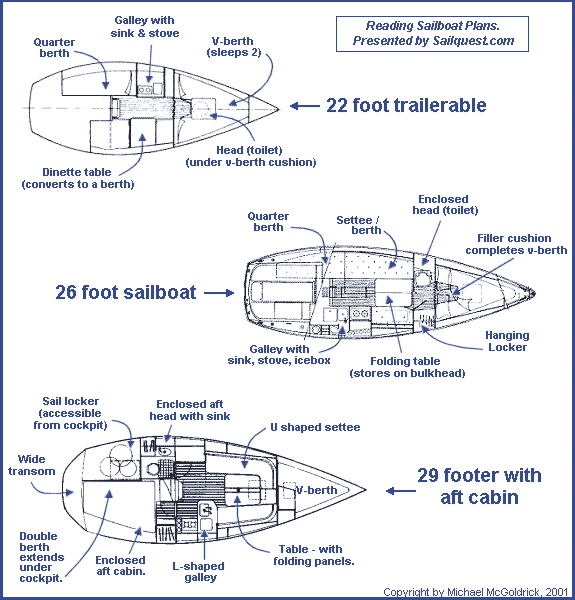
[ Return to Home Page ] [ Return to Best Sellers Menu ]
|
[ Scroll down for an illustration about reading sailboat accommodation plans. ] L.O.A. = Length Overall. In the Canadian used market, the LOA is usually taken to be the maximum length of the deck from the bow to stern (or the actual hull if the boat has a reverse transom). It does not normally include a bowsprit, but there are exceptions to this rule (such as with the Bayfield models). Moreover, some manufacturers from France give an LOA based on a maximum length which includes any part of the boat, such as an overhanging bow pulpit (bow rail) and any outboard mounted rudder. This will often give the impression that a boat is 2 to 3 feet longer than it really is. L.W.L = Length of Waterline. The longer the waterline, the faster the theoretical speed of a displacement hull. The theoretical speed of such a hull can be determined by multiplying the square root of the waterline by 1.34 (although many people believe that using a multiplier of 1.5 will give a result which is closer to the top speed of a displacement hull in the real world). Beam. The beam is the maximum width of the boat. Note that trailering a boat with a beam of much over 8 to 8.5 feet (2.43m to 2.58m) will usually require a special permit in most jurisdictions. Draft. The depth of the keel when the boat is floating on its designed waterline. Expect the draft to increase when the boat is fully loaded for cruising. Boats with deep fin keels will generally have good windward performance, but the extra draft may keep them out of some nice anchorages. Boats with swing or retractable keels will usually not point into the wind as well as boats with fixed fin keels. Displacement. This is the weight of the boat, or more precisely, the weight of the water displaced by a partly loaded boat. The numbers given by manufacturers are good for general comparisons, but they do have different ways of arriving at their displacement figures. Don't be surprised if some boats weigh quite a bit more than their published displacement figures in the real world. Sail Area. Wherever possible, this website attempts to give a value in square feet (and metres² ) for the total area of the mainsail and 100% of the foretriangle (the foretriangle is the total area between the mast and forestay). However, in addition to the mainsail, some manufacturers use the working jib or even a 150% genoa instead of the foretriangle to calculate the total sail area. Unfortunately, it is not always obvious which method is being using to calculate the published sail area of a boat. Vertical clearance. The mast height above the waterline. Berths. Places where people can sleep onboard (beds). Most settees and dinettes convert into berths. Sailboat manufacturers tend to be a little optimistic with the number of people that can sleep comfortably on a boat. This website attempts to give a range which covers the realistic to maximum number of people that can sleep on a particular boat. Headroom. Don't expect standing headroom in boats under 25 feet in length (although there are a few exceptions). Headroom is typically measured at the highest point under the coach roof, and it will usually decrease as one moves forward in the cabin. Head. The nautical term for the toilet. Many boats up to 26 feet in length are equipped with a "self-contained" plastic toilet (head) which comes with a built-in holding tank with a capacity of 3 or 4 gallons. If used sparingly, such a holding tank might be sufficient for a family of four out on a weekend cruise. In Canada, heads must be permanently installed (can not be portable) and must be fitted for deck pumpout. Larger boats (and some smaller boats) will usually be equipped with porcelain head and separate holding tank with a capacity of at least 10 to 12 gallons (usually more). Rating (PHRF). The number given is the base handicap rating for a boat racing under the Performance Handicap Racing Fleet (PHRF) rule for the Lake Ontario area. Faster boats will tend to have a lower number, while slower boats have a higher handicap rating. For more information about this handicap rating rule, see the PHRF Lake Ontario Web Site. Power. Outboard motors up to 9.9 horsepower are often used to power boats up to 26 feet in length. (These outboards usually have a long shaft and a low pitch propeller.) Boats over 26 feet in length are generally fitted with an inboard motor. Boats powered with an inboard that were built after 1980 will most likely have a diesel. Price. The prices given on this website are in Canadian dollars and cover the low to mid range for boats that are in reasonably good condition, are fairly well equipped, are listed in central Canada, and that are of average age in relation to their production run. These factors can vary considerably from model to model. Note that the used market tends to be most competitive in and around the Toronto area.  by Michael McGoldrick. [ Copyright & Disclaimer ] |
[ Return to Home Page ]